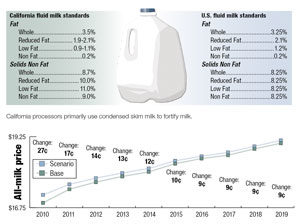A recently released economic analysis by economists at the University of Missouri’s Food and Agricultural Policy Research Institute (FAPRI) shows changing U.S. fluid milk standards for inclusion of nonfat solids to those used in California would have a significant short-term increase in all-milk price per hundredweight. The analysis was commissioned at the request of the four co-chairmen of the Congressional Dairy Farmer Caucus, Congressman Joe Courtney, Congressman Timothy Walz, Congressman Devin Nunes and Congressman Peter Welch.
(Click the image at right to open and view at full size in a new window.)
Assumptions
Researchers assumed that no make-allowance would be provided to processors if the change were made, although California currently provides processors a .0987 per pound of nonfat solids allowance. The study also assumed there would be no change in demand for fortified fluid milk.
No assumptions about which products would be used to fortify milk were made. (California processors primarily use condensed skim milk to fortify milk.) In the past, studies and proposals to change fluid milk standards have assumed nonfat dry milk (NFDM) would be used to fortify milk, as stockpiles of NFDM have existed.
The new report says: “The market situation is very different today than when those studies were conducted. Uncommitted inventories of nonfat dry milk are virtually non-existent in the current 10-year baseline.”
Use of NFDM is expected to rise from 528 million to 851 million pounds by 2019, even without policy changes, the report says.
Results
Fluid milk consumption would decline slightly, according to the analysis, as retail milk prices would increase between 16 and 18 cents per gallon. However, the increased use of nonfat solids use in fluid milk would account for 350 million pounds of nonfat solids. Use of these solids would increase all-milk prices 27 cents per hundredweight in the first year and steadily decline to 9 cents as production, following higher prices, would eventually grow to fulfill this new demand.
Read the entire report at: http://www.fapri.missouri.edu/outreach/publications/2010/FAPRI_MU_Report_07_10.pdf PD
PHOTO: The largest increase in milk price of $0.27 per cwt. occurs in the first year of the analysis and is reduced in subsequent years as milk production grows due to producer response to higher milk prices,” a new report says.




